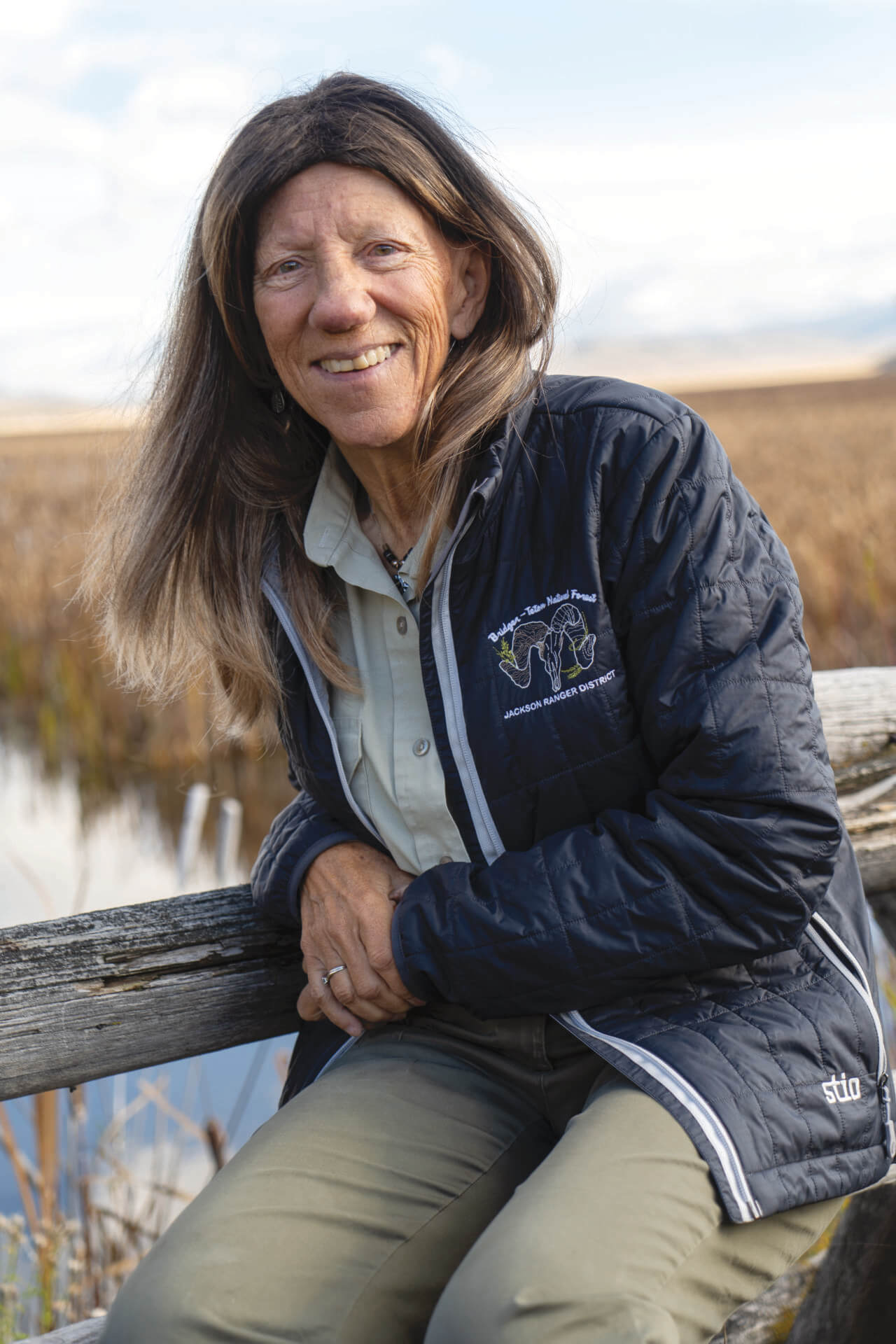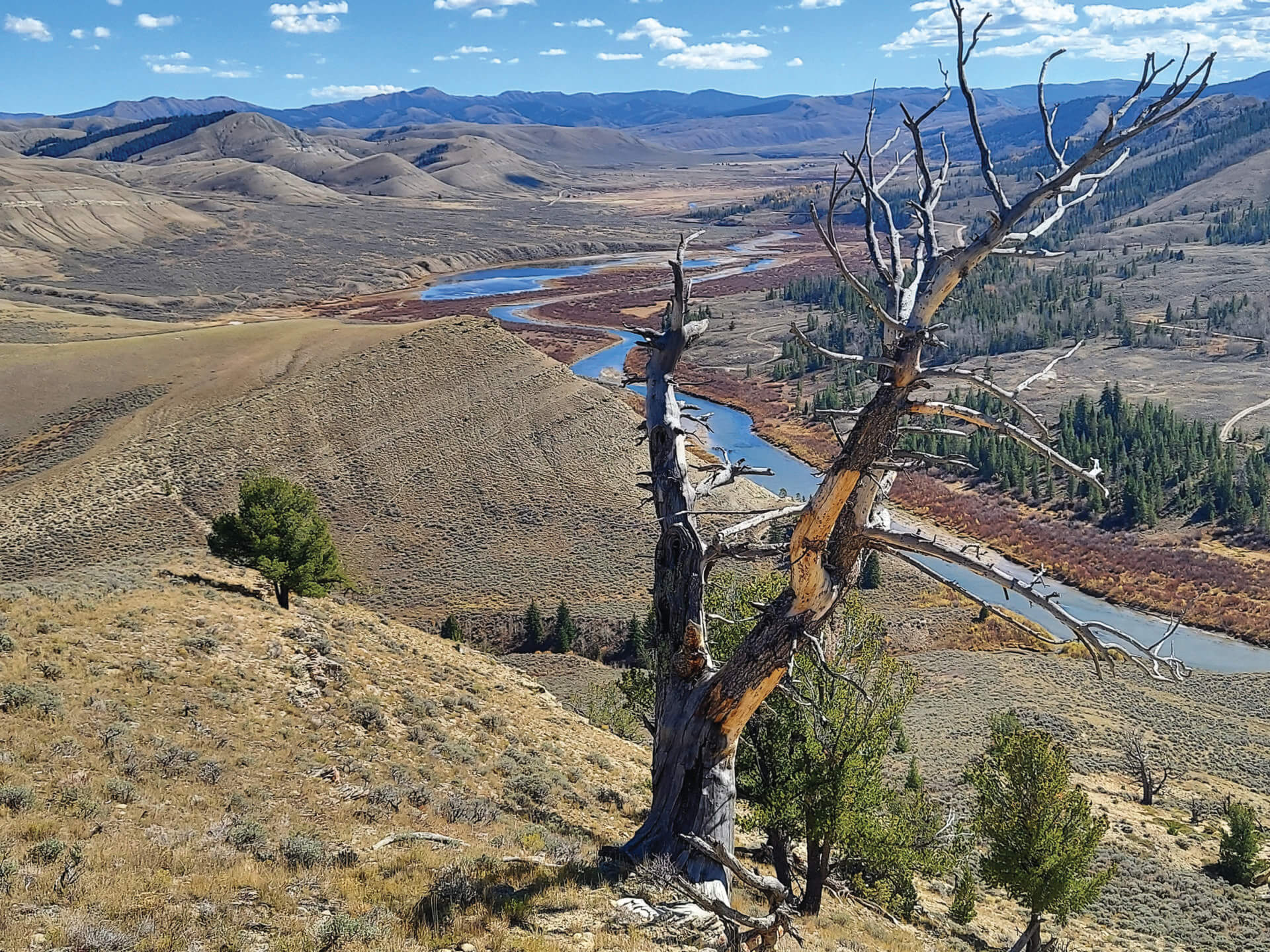Read The
Current Issue
Linda Merigliano
The Wilderness Diplomat
//By David Gonzales

In 1991, soon after joining the staff of the Bridger-Teton National Forest as a wilderness planner, Linda Merigliano was dispatched to the tiny town of Cokeville, Wyoming, to speak at a meeting of snowmobilers about why snowmobiles aren’t allowed in designated Wilderness Areas. “I said, ‘Northwestern Wyoming, this is wild country. So, logically, we’re going to have a lot of wilderness here. In Florida, you grow oranges so, there’s oranges down there. And there’s wilderness here.’ They didn’t like that analogy,” she says with a laugh.
Since then, Merigliano’s public communication skills have improved as she has deftly navigated, arbitrated, and negotiated many of the thorniest issues that have arisen over local public lands in the last two decades. As the recre-ation program manager for the Bridger-Teton—the fifth largest national forest in the Lower 48, which is also adjacent to two wildly popular national parks—Merigliano oversees the complex and constantly tested interface between eager forest fun-seekers and 3.4 million acres of remote, rugged country. Her experiences have led her to become locally renowned for what can only be described as wilderness diplomacy.
You’ll find very few people in Jackson Hole who have the reverence for the Wilderness Act of 1964 that Merigliano has. As she tells it, she was practically born into it. Growing up near Schenectady, New York, her first favorite forests grew on the slopes of the Adirondacks, which, she points out, were crucial inspiration for Howard Zanhiser, lead author of the Wilderness Act.
Merigliano started her career as an Adirondacks trail worker while on summer break from Cornell University, and it was in this capacity that she met Mike Merigliano, himself an expert trail restorer. “We immediately clicked and had lots of long conversations in the woods,” she says. When she graduated from Cornell, she followed Mike to Idaho, where he was attending grad school at the University of Idaho to become a plant ecologist. In the late 70s, there were few jobs in natural resources management, so Merigliano was happy to land a job as a student conservation associate (“basically, a volunteer,” she says) on the west slope of the Tetons, where she would spend the next 11 summers as a backcountry ranger. “I know the west side of the Tetons really well,” she says.
In the off-season, she and Mike worked at Grand Targhee Ski Resort as ski instructors, lift operators, front desk attendants—whatever was needed. Money was scant and jobs were scarce, especially on the west side of the Tetons. “In Jackson, we were all known as the pigs from Driggs,” she laughs.
In the mid-80s, Linda also attended grad school at the University of Idaho, where she steeped herself in wilderness politics. “I got hooked up with David Cole and other folks who were working on a “limits of acceptable change” system for protecting natural ecosystems from over-recreation,” she says. In 1988, her expertise in wilderness policy was noted by a fellow ranger who’d gone to work for Bruce Vento, a U.S. Congressman from Minnesota who needed “boots-on-the-ground” rangers to testify at oversight hearings about wilderness management. This gave Meri-gliano a once-in-a-lifetime opportunity to testify in front of Congress about her favorite subject. As the headline in the Casper Star Tribune reported, “Forest Service not doing enough for wilderness, rangers tell panel.”
Fated to do enough, or more, Merigliano was soon recruited by the Aldo Leopold Wilderness Research Institute to create wilderness conservation training courses for Forest Service officers around the country. In 1991, she was invited to join the Bridger-Teton as a wilderness planner, and in 2000, became the forest’s recreation program manager.
Tom Kovalicky, former forest supervisor for the Nez Perce National Forest, had previously told Linda, “You’ve got to figure out early in your career what legacy you want to leave, what change you want to make. Get yourself into the position where you can most affect that change, and then don’t let anybody move you out.” Linda took this advice to heart and has stayed in the recreation manager position since the turn of the millennium, navigating an unending string of controversial forest recreation issues.

“You’ve got to figure out early in your career what legacy you want to leave, what change you want to make. Get yourself into the position where you can most affect that change, and then don’t let anybody move you out.”
First, there was the increasingly lawless nature of the Snake River, so Merigliano focused on writing a new Snake River Plan and establishing the Snake River Fund, a happy collaboration with local donors who came forward to cover the costs of improved boat ramps and parking lots. Then there was the troubling expansion of illegal mountain bike trails on Teton Pass. At the time, Merigliano thought, “We’re not going to just play this cat-and-mouse game of trying to close trails when they’ll just be opened again.” She recruited her friend Keith Benefiel, a local biking icon, to negotiate with the “Teton FreeRiders” to compromise on a settled trail system that included the best of the new trails.
“I got a lot of calls from Forest Service people across the nation,” Merigliano says. “They were angry. ‘What the hell are you doing allowing downhill bikes in the forest?’ This was totally new at the time. Looking back, we could have made some slightly different decisions, but the illegal trail building ceased.”

Not long after this, Merigliano stepped into the morass of creating a new Motorized Travel Plan for the northern half of the BTNF. Putting new limits on off-road vehicles invited backlash, but Merigliano wisely teamed up with the two local businesses who rented off-road vehicles to promote the plan. “So, they were saying good things about it in the paper, which was instrumental,” she says. When the winter plan was implemented, there were no appeals—rare in such a process.
With the pandemic came a blizzard of new problems, thanks to an explosion of dispersed camping. The Forest Service’s solution is what Merigliano considers her proudest career accomplishment: the Ambassadors for Responsible Recreation. Facilitated by funding from the nonprofit Friends of the Bridger-Teton, these volunteers live at the busiest dispersed camping areas in the northern part of the BTNF and monitor the areas while also educating campers about how to practice responsible recreation. They quickly proved their value by quenching hundreds of abandoned campfires in their first few summers. Soon, Merigliano will be tackling the issue of people on electric mountain bikes wanting increased access to trails. “The questions are: Where is the appropriate place for this? And, how do we set it up so that we’re not regretting our decisions down the road?” she says.
At 65, Merigliano is feeling the tug of retirement (in which she hopes to spend her days as a local trail ambassador), but she doesn’t want to take herself out of the conversation too soon. “A lot of people who go into natural resources aren’t real comfortable with working with the public, and that is 100 percent of the job,” she says. “The public has to be involved. It’s their land, right? And I have this naive optimism that with enough education and information, people do the right thing.”

Special Spots on the BTNF
“I’ve made the drive over Teton Pass nearly 10,000 times over the last 32 years, so it has been memorable to witness the seasonal changes year after year and see what has changed and what stays the same. It is a special place—for its trails, skiing, flowers, history, moose, aspens, and scenic views.
At Deep Lake in the Bridger Wilderness, I love granite slabs and the majesty of being in an amphitheater of massive peaks.
Alkali Ridge in the Gros Ventre Wilderness has differing colors in the rock formations, views of the Tetons, a great view of Crystal Creek slide and the Gros Ventre River drainage, and I’ve followed the tracks of lions there.”
Hiking Essentials
As a seasoned backcountry ranger and a lifetime wilderness explorer, Merigliano never leaves the house for a hike without these essentials.
1. A headlamp: “It seems like you’re always walking out of the woods in the dark,” she says.
2. Socks. “This is for overnight trips. I remember all the rangers used to say that a pair of dry socks was essential. You have to take care of your feet.”
3. A paper topographic map (as a backup for GPS apps on smartphones). “Mike and I were in the Winds this summer and ran into a group trying to navigate Jackass Pass with their phones. It’s hard to see the big picture on a phone, and they were confused. I remember we pulled out our paper map to show them where they were. Paper maps are always handy, but they’re especially useful if your phone dies.” JH




